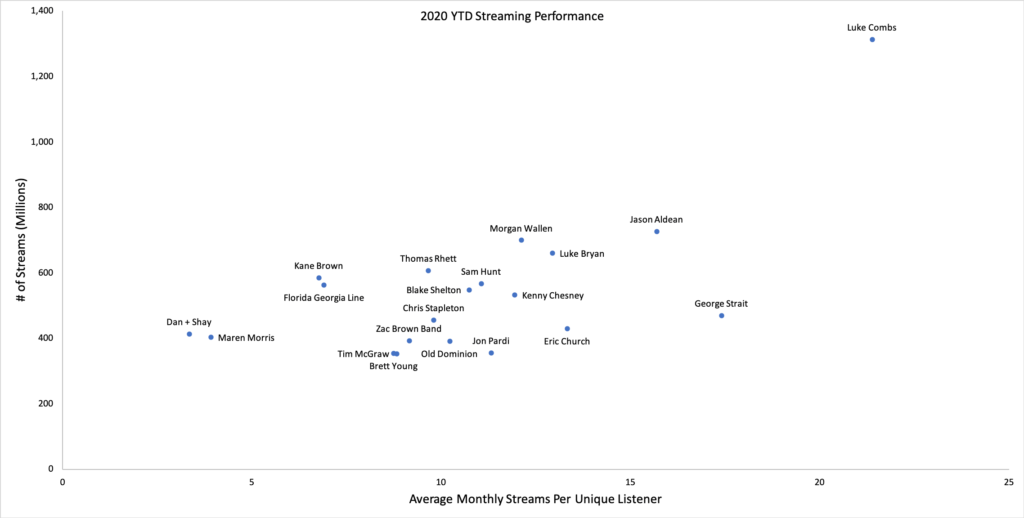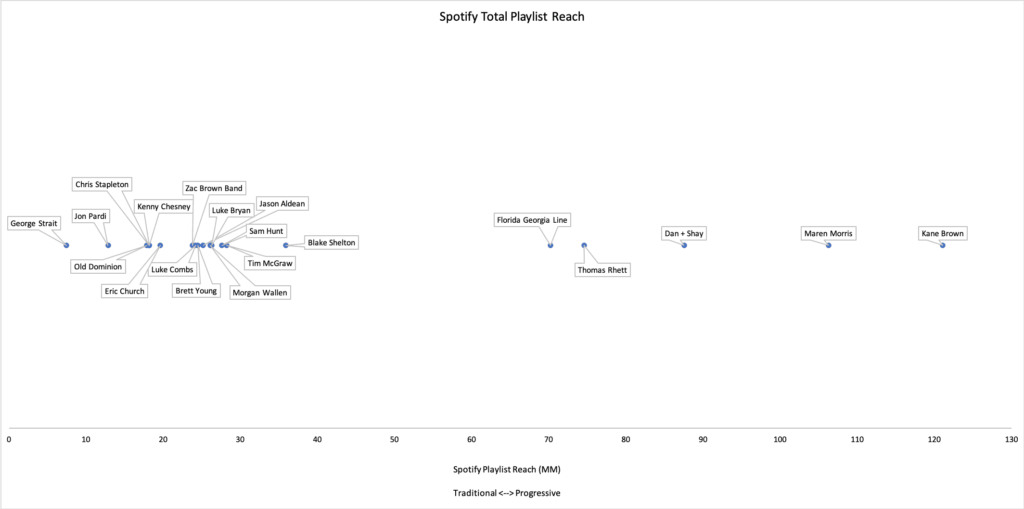Last week, Hits Daily Double published a report with the stream counts for the top twenty country artists thus far in 2020. As we noted here on Whiskey Riff, these results look very similar to radio trends over the last few years: Luke Combs and the major labels have dominated while women are almost nonexistent.
Given the state of country music, these numbers are hardly surprising. However, given the range of styles and age between the artists on this list, I set out to determine how each artist was able to rack up that many streams. To do so, I recreated the chart with expanded fields detailing key performance indicators on Spotify. While the report does not specify what platforms are included in the streaming counts (Spotify, Apple Music, Amazon Music, YouTube, etc.), Spotify has the largest market share and therefore represents a suitable view of fan consumption.

As you can see, the table is a heatmap which highlights data points based on their value: green for the highest numbers in that column, red for the lowest values. Total year to date streams is shown in millions in the first column of numbers, with the additional data split into two sections relating to monthly listeners and playlist reach.
Spotify Monthly Listeners
This segment features a look at the number of monthly listeners each artist has on Spotify. This is the quantity of unique users that have listened to said artist at least once in the last 28 days. The first column shows this figure for each artist in February and the next column shows the same for August. The following field shows the percentage change of monthly followers from February to August. With the exception of Dan + Shay, the majority of artists saw a sizable increase in monthly listeners over this time period.
The overall growth in monthly listeners for the top twenty was 19%, which is very consistent with Hits Daily Double’s reporting of 21.5% growth in country streams YTD. While February to August is only around half a year, the global pandemic has drastically impacted people’s lives and changed their consumption patterns. It makes sense that with social distancing guidelines and more people at home throughout the day, streaming has increased as a form of entertainment.
Interestingly enough, the artists with the most monthly listeners and highest growth did not necessarily have the most streams. In fact, it was nearly the opposite. Dan + Shay and Maren Morris had the most amount of listeners in February, yet they were toward the bottom of this list. In comparison, Jason Aldean (6.1 M) had roughly a third of the monthly listeners as Dan + Shay (18.1 M) in February, but nearly double the streams (726 M vs. 413 M). How is this possible?
The answer to this question is that on average, some artists see much higher fan interaction than others. This is quantified in the streams / listeners column, which is calculated by taking the total streams divided by the sum of monthly listeners from each month (January through July). Naturally, the artists with less monthly listeners and more streams have significantly higher streams per listener. This provides a baseline for quantifying average level of fandom, with artists that have large monthly streams per listener indicating a fanbase that on the aggregate listens to said artist repeatedly as opposed to infrequently. When you plot streams per listener vs. total streams, a very clear trend beings to emerge.

Once again, Luke Combs is simply in a different world. His 21.4 streams per listener and 1.3 billion total streams are incredibly higher than the next artists in those categories. However, moving from right to left you can visually see the artists with the next highest streams per listener are George Strait, Jason Aldean, Eric Church, Luke Bryan and Morgan Wallen. The lowest four artists in this category are Dan + Shay, Maren Morris, Kane Brown and Florida Georgia Line. I’m not a supporter of defined sub-genres, but it’s apparent that the artists that lean more toward musical production akin to pop see more monthly listeners but less streams from those listeners. There is a simple reason for this: playlisting.
Total Spotify Playlist Reach
Just as it’s a battle to achieve airplay on country radio, getting songs added to streaming playlists is a similar aspiration for artists looking to grow their fanbases. The last section of the above heatmap shows the number of playlists each artist has songs featured in, as well as their total reach. The total reach is calculated by adding the number of followers of each playlist that an artist has a song on. While there is obviously overlap as users can follow as many playlists as they choose, the measure of total reach gives a clear scope of each artists’ access to fans.
To continue with the same trend, the more pop oriented artists such as Kane Brown, Maren Morris and Dan + Shay have the largest amount of reach. This is not necessarily because they are featured in significantly more playlists, it’s because the playlists they are featured in have a much larger following (see average playlist reach). This inherently makes sense as the pop genre has a much larger overall fanbase, so playlists with that type of music provide enhanced gateways to that pool of fans. Along those lines, pop collaborations performed by Kane Brown (“Be Like That”, “Cool Again”), Maren Morris (“The Middle”) and Dan + Shay (“10,000 Hours”), are likely to be featured in pop playlists – increasing their reach on the platform considerably.

The numbers certainly reflect this hypothesis, as Kane Brown’s reach of ~121 M is nearly five times as large as Luke Combs’ reach of ~24M, even though Combs is the most popular act in the entire genre right now. As shown by the final column (Listeners / Reach), the artists with very large reach generally convert less of those playlist followers to listeners. The idea is that users will be exposed to artists by discovering new music via playlists, eventually leading to fandom and continued consumption of that artist’s music. The question then becomes, is the low percentage of fan conversion on highly followed playlists offset by the sheer access it provides? The short answer is yes.
The reason there is such a large emphasis placed on successful playlisting is that there is a direct relationship between total playlist reach and monthly listeners. In fact, 91% of the variation in monthly listeners for these twenty artists can be explained by total playlist reach. While this is a relatively small sample size, the results are extremely impactful:
On average, an extra million units of Spotify playlist reach yields 105,000 additional unique monthly listeners.
This is extremely significant and speaks to the influence of curated streaming playlists. Large entities, including Spotify itself, have continued to grow their impact within the industry by hand picking songs to be included in their playlists. These playlists are often the most followed and therefore hold the key to artists amplifying their voices to new fans. And similar to the country radio data we compiled last week, women (aside from Maren Morris) are not even a part of the conversation. Maren is the only female artist artist in the Top 20, landing at #15 in terms of total streams.
Moving Forward
So, what does this mean for country music? As radio continues to lose its stranglehold on the genre to streaming, playlisting will becoming even more important. Those concerned with the purity of country music might then be very troubled with these trends. Clearly, making music that fits on pop playlists with huge followings is effective for gaining access to new fans and having success on streaming platforms. Therefore, country artists are incentivized to make increasingly pop friendly music.
Yet this does not mean the end of the neotraditional revival we have seen in recent years is near. Based on the numbers, there are two distinct ways to achieve massive streaming success like the twenty artists on this list. One is the Kane Brown approach – create pop leaning country music that is easy to playlist but achieve less streams per listener. The second is how Jon Pardi has launched his career – growing a loyal fanbase through a more natural process resulting in less but more engaged listeners.
While there are some artists that may choose to follow in Kane Brown’s footsteps, I believe in the long run the alternative will prevail. Exemplified by the huge demand for more traditional music by Luke Combs, Jon Pardi and even George Strait and Chris Stapleton, having a grass roots fan base is more valuable for touring. Loyal fans are more likely to buy tickets to live shows where artists make the majority of their revenue. Yes, Kane Brown has done impressive touring numbers in the last few years, but it is still to be determined if this success can be sustained.
In order to have a long-lasting career such as George Strait, who is in the top twenty for streaming numbers in 2020 at the age of 68, artists must develop devoted fans who support their music beyond just short-term trends. Streaming platforms can prop artist popularity up on viral playlists, but ultimately this cannot last. The artists that will be remembered are those that truly captivate their audiences and create fans that support their music for a lifetime.
And speaking of streaming, make sure to check out the official Whiskey Riff Playlist Channels for some of the best playlists in country music. Featuring New Music Friday, Modern Day Outlaws, Saved By ’90s Country, Texas Country, Yellowstone The Soundtrack and more, there’s guaranteed to be something for everybody.





